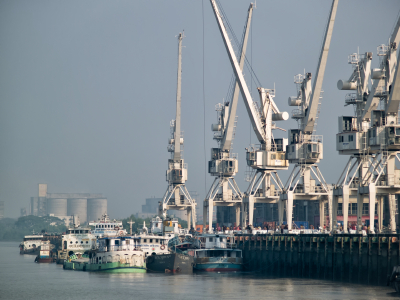
U.S. and European retailers have adopted two different programs to protect garment workers.
Two Bangladeshi garment factory tragedies—a devastating fire at Tarzeen Fashions Limited that killed 112 workers last November, and the collapse of Rana Plaza that killed 1,127 workers earlier this year—have prompted two private sector initiatives to improve safety in Bangladeshi plants. Trade unions, with support from some seventy mostly European fashion and retail brands, pushed the first initiative, known as the Accord on Fire and Building Safety in Bangladesh, which was announced in May. Last week—at the same time that the union-backed group began implementing its Accord—seventeen U.S. clothing companies and six trade associations announced their own program, the Alliance for Bangladesh Worker Safety. How do these two initiatives approach the challenge of promoting worker safety in Bangladesh? What can we expect these initiatives to achieve in terms of safety improvements?
The two initiatives have much in common. They both are premised on the notion that fashion and retail brands are at least partially responsible for the safety of workers in the factories that make the products they sell. Both use independent inspectors to monitor workplace conditions and both include mechanisms to bring unsafe workplaces to the attention of the brands that buy Bangladeshi-made clothing. Both levy fees on brands to fund operating expenses. Both expressly seek to build on the National Tripartite Plan of Action on Fire Safety, an earlier agreement forged by representatives of Bangladeshi government, employers, and workers developed in the wake of the Tarzeen Fashions fire. Perhaps most important, both of the recent initiatives call on brands to sever business relationships with Bangladeshi factories that persistently fail to meet safety standards.
Although labor groups have criticized the U.S. fashion and retailer effort as a watered down version of their own Accord, in some respects the US corporate Alliance looks to be more ambitious. It pledges that common safety standards will be in place in factories supplying member companies within 3 months—by October 2013—and that 100 percent of Alliance factories will be inspected within the first year. The labor-backed Accord instead calls for tiered oversight based on whether a factory is a primary, secondary, or tertiary supplier of the participating brand. Primary suppliers must submit to safety inspections, remediation, and worker training, while tertiary suppliers undergo only limited inspections. Inspectors must do their best to complete inspections, where required, within two years.
When it comes to the potential for sanctioning non-compliance, however, the labor-backed Accord appears stronger. While the U.S. corporate Alliance recognizes the important role that Bangladeshi workers play in adoption of safe practices, only the labor-backed Accord allows workers to take retail brands to arbitration, and even to court, should they fail to comply. In addition to providing for the possibility of tough sanctions imposed on brands, the labor-backed Accord offers stronger incentives to factories to improve their safety performance. It encourages brands and factories to work together to find ways to make ongoing investments in safety more commercially viable. Brands may, at their option, “use alternative means to ensure factories have the financial capacity to comply with remediation requirements, including but not limited to joint investments, providing loans, accessing donor or government support, through offering business incentives or through paying for renovations directly.” Brands are expected to maintain long-term contractual relationships, for a minimum of two years, with plants that invest in safety.
These requirements in the Accord recognize that improving safety in Bangladeshi factories is not just a matter of setting and policing safety standards. As Richard M. Locke argues in a recent book on private sector labor standards, too often market demands make investments in safety and other types of worker protections nearly impossible. If factory owners spend too much on factory improvements, or limit the number of extra hours they expect from workers, they may lose a contract from a brand determined to maintain low prices and shorten production times. Improving safety is not merely a matter of implementing a checklist and sanctioning non-compliance. It’s also about establishing a pervasive awareness of and commitment to safety — and a willingness to pay the associated costs. In addition to strengthening mechanisms for oversight and sanctioning, global brands need to build the capabilities of Bangladeshi factory workers and owners themselves. Changes that endure beyond a few production cycles will require collaboration among brands, factories, and government.
When it comes to improving workplace safety in Bangladesh, both the Accord and the Alliance are promising initiatives, but their outcomes are by no means clear. Neither initiative, at least so far, specifies the safety standards that factories will be required to meet. Are they the same as the standards required of plants built and operated in the United States and Europe? Or will they be some less stringent set of standards? Also, even though both initiatives have set a five-year timeframe for achieving results, it remains to be seen whether that period will be sufficient to make fundamental changes that achieve lasting improvements in working conditions.
Taken together, the Accord and the Alliance do demonstrate the pressures brand-name retailers face to improve workplace conditions halfway across the globe. They also reveal the competitive pressures they face from each other. Brands that market clothing to U.S. and European consumers cannot ignore unsafe conditions in supplier plants, and U.S. fashion and retail brands cannot ignore the initiatives of their European competitors. With these dueling standards, we are seeing a ratcheting up of expectations for corporate conduct. Ultimately, the results may fall short of the laudable and ambitious goals that advocates aspire to achieve and workers deserve; however, these initiatives are still steps in the right direction.




